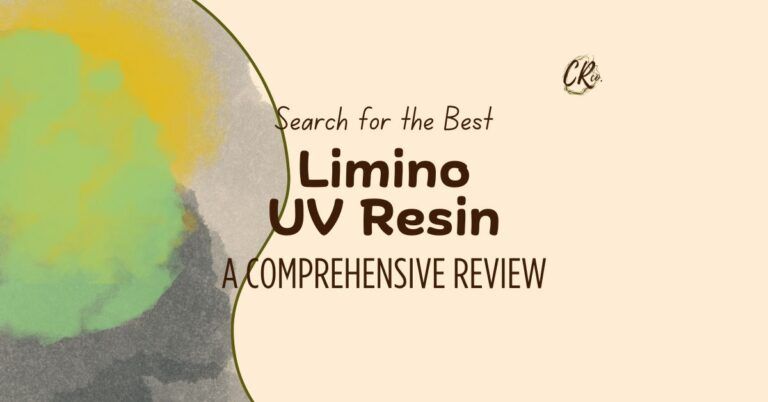How to Mix Bubble-Free Epoxy Resin
Achieving a bubble-free epoxy resin mixture has as much to do with the mixing method used as it does the brand of epoxy resin used. It is important to use a brand that is formulated to release bubbles quickly, but you can help keep the bubbles to a minimum if you follow the tips below. Here are the best tips on how to mix bubble-free epoxy resin for your next resin art project!
Measure and Mix According to Directions on the Bottle
Mixing Ratio
No matter the brand of epoxy resin you choose, you need to follow the directions on the bottle. Most epoxy resins require a 1:1 ratio of epoxy resin and hardener. However, there are a few brands where this differs. Another mixing ratio you may see is 3:1, epoxy resin to hardener. Just make sure you are cognizant of what the specific directions say for the specific type of epoxy resin you are using.
Weight Vs. Volume
You may encounter varying directions with regard to measurements. Most epoxy resin brands instruct you to measure by volume. However, others call for measurements by weight. If the directions call for measurements by volume, you can use a plastic or silicone measuring cup. On the other hand, if the directions instruct measuring the components by weight, you need to purchase a scale to do so. Here is an affordable one that I recommend:
Use Silicone or Plastic Products with Epoxy Resin
I suggest you buy a cheap silicone measuring cup, like this one listed on Amazon:
(It even comes with silicone stir sticks, which you will use, and little finger condoms, which you probably will not, but who does not love a freebie?)
Mix Thoroughly/ Avoid a Sticky Mess
When mixing, be sure to mix thoroughly. You will know the product is mixed when you stop seeing strings of resin in the cup. Also, be sure to scrape the sides and the bottom of the cup to ensure thorough mixing. If you do not do this, you may end up with sticky parts on your project.
Mix Slowly/ Avoid Bubbles
Another great tip is to mix slowly. Mixing slow helps prevent air bubbles in your epoxy resin.
Wooden Stir Sticks=More Bubbles
If you have issues with air bubbles, you may also want to switch up your stir stick. A wooden stir stick, being porous, may also introduce extra air bubbles into the epoxy resin while mixing. Using a silicone stir stick will prevent this problem.
Epoxy Resin MIxing Machines
Following all of these simple tips greatly increases the chances that your epoxy resin mixture stays bubble-free and crystal clear! There are some great epoxy resin mixers on the market today, and unfortunately, there are some scams as well. One of the biggest scams I have seen looks like a milk frother. In fact, I think it is the same machine, rebranded for mixing epoxy resin. It does not work. It is a completely useless purchase for use with epoxy resin. Here is what this machine looks like. I highly suggest you do not waste your time trying it.
If you are really attempting to mix bubble-free epoxy resin, the best method is to use a silicone stir stick and mix by hand. This allows you to control the speed of mixing, as well as how much air is folded into the epoxy during the mixing process. If you are not as worried about bubbles, or you are mixing a large quantity of epoxy resin, I recommend using a paint mixing drill attachment and a drill. Here is the attachment I use when mixing large quantities of resin:
For a resin mixing machine that actually works for smaller quantities, I recommend the following:
(Just be sure to wash the mixing stick off after mixing so epoxy resin does not build up on the end)
For good old fashioned, by hand mixing, here is the kit I recommend:
Thanks for reading and leave any questions in the comment section below! Happy crafting!
Share On Socials!
Share on facebook
Share on twitter
Share on linkedin
Share on pinterest
Share on reddit
Share on vk
Share on odnoklassniki
Share on tumblr
Share on digg
Share on skype
Share on stumbleupon
Share on mix
Share on telegram
Share on pocket
Share on xing
Share on whatsapp
Share on email






I’ve only mixed epoxy resin once in my life and fortunately, it was smooth with no bubbles and worked perfectly. That said, it was a flook I think although I always read and follow the instructions and take it slow. I guess I did all the things you said by default and it worked out really well. I’ve also used builders bog and you have to take care with this as well. It goes off super fast, so you can’t work slowly. What sort of things would you use epoxy for?
Lily-
Epoxy resin can be used for tons of things! Some of the things I use it for are making coasters, paintings, bookmarks, jewelry, grinders, and so much more. I have also done custom countertops with epoxy resin. In the past, others have used epoxy for garage floors, and even shower walls! Here are some great epoxy resin art tutorials to check out and maybe try for yourself!
I was aware that you needed to use care when mixing epoxy resin to get it to be bubble free, but I didn’t realize that certain brands were preferred over others because they tend to cause less bubbles. Also, love that you warn against using epoxy mixing machines. I’ve also found them to be useless.
Machines have their time and place, but if you are worried about bubbles, they really are tough to use. Mixing slowly by hand is the best way to ensure that air does not get mixed in. Yes, some brands are much less prone to bubbles. Look for an article soon about which brands are best!
Well, thanks for sharing a great article. I have to say that i found it to be a very interesting and informative read indeed. I dont have any plans on mixing epoxy resin at any time in the near future but it was some interesting facts to learn here all the same. Besides, you never know when you might need to eh
Very true Kwizdin! You know where to find us if the need should ever arise!
I always wanted to try resin and your article looks like the place to go to, as it’s very helpful and full of good suggestions. Knowing myself I will mess it up first, no matter what 😀
But this is a very informative and detailed article on epoxy resin. I think I’m going to try it next month. So wish me luck!
Thank you again!
j.
Thanks, Reka. Please let me know if you have any questions when you give it a try! You won’t mess up as long as you follow the directions to a tee!
Hey Ashley,
Thanks for the tips! I am making some huge tables out of some rough-cut solid oak from my woods. I have done some intricate designs on the surface with a torch and a wood burner. I will be coating them with a clear epoxy resin to make the top smooth and fill the indentions from the design.
Having these tips, like using silicone utensils will be a big help because I have a lot of time in these pieces and do not want bubbles! I was looking at how to use the epoxy and found this article, I wasn’t even thinking about bubbles so thank you so much!
Chad
Oh fun!
Chad, I commend you for taking on such a huge project. They are always tedious but look so beautiful when they are finished.
Definitely keep these tips in mind and I suggest purchasing a Silicone Coated Paint Mixing Drill Attachment to mix your epoxy. Then, use your drill on a low speed to mix.
Key to bubble free deep pours will be using a bit of heat after you pour and using the right epoxy resin. If some areas of your table are more than an inch deep, get a good deep pour epoxy resin. Check out What Epoxy Resin to Buy: Recommendations for Resin Artists.
If you have any questions, let us know! Thanks for stopping by!!!